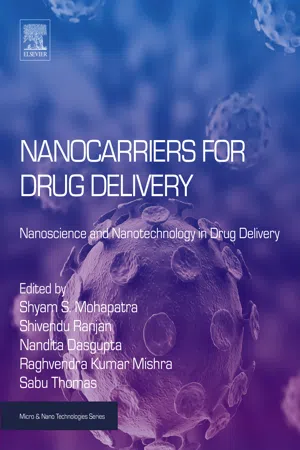1. Introduction
Advanced nanomaterial therapeutic systems hold particular advantages over conventional therapeutic systems. Most commonly, accelerated removal of drugs by scavenger cells can be constrained by modulating the size of nanoparticles (NPs). The capability to capsulize and transport inadequately water-soluble drugs offers affirmative potency for pharmaceutical applications. The reliability of controlled drug release allows modifying the pharmacokinetics of drugs and diminishing their toxic and side consequences. Ultimately, enhanced biodistribution and boosted intracellular penetration enhance the efficiency of drugs [1,2].
The aforementioned assets of NPs satisfy the conditions to enhance chemotherapy for cancer, in which it is important to keep the desired drug levels in tumor tissue and to weaken the drug concern for healthy tissues. NPs of optimal size can move through the capillary vascular walls and assist in passive tumor targeting because of the consequences of strengthened permeability and retention on the tumor vasculature. The elevated permeability of the tumor neovasculature improves the extravasation of NPs due to extensive gaps between vascular endothelial cells and obstinate angiogenesis inside specific tumors. Moreover, impaired tumor lymphatic drainage behaves synergistically toward the accumulation of NPs in the tumor environment. However, precise receptors overexpressed on the membrane of tumor cells can be victimized to produce requisite targeting ligands that adhere to the NPs. In this respect, it has been noticed that specific ligands such as vitamins, lectin, carbohydrates, antibodies, and fragments of some antibodies can mediate endocytosis, thereby extending the selectivity of drug delivery [3–5].
Normally, the biodistribution of NPs is profoundly reliant on their geometrical properties, size, shape, and also surface properties. In this regard, a significant number of NPs have actually been produced and executed, for instance, nanovesicles, nanomicelles, nanoliposomes, and nanogels, together with nanodendrimers. These NPs can be described in terms of their constituting components, like polymeric NPs, mesoporous NPs, magnetic NPs, gold NPs, and so forth. Among the wide range of materials that are utilized for developing the polymeric NPs, organic and natural polymers manifest certain positive aspects in their versatility of style and design, modification, synthesis, and active functionalization. Specifically, NP-dependent amphiphilic polymers show a noteworthy involvement in the delivery of poorly water-soluble tablets, along with other medicines. The polymer is usually applied for biocompatible purposes, for example, copolymers of polycaprolactone, poly(glycolic acid), polyethylene glycol, poly(lactic acid), polysaccharides, polypeptides, etc. In addition, polysaccharides are thoroughly employed as the elementary unit for the synthesis of drug-delivery vehicles. Nowadays, many lipids and also artificial polymers are unquestionably employed as drug-delivery vehicles [6–8]. Plenty of nanocarriers for tumor therapy mostly driven by nanomaterials have evolved and additionally shown remarkable results in preclinical tests in recent decades. Amphiphilic NPs, specifically in carbohydrate- as well as their derivatives-based NPs, are taken into account and manufactured using several chemical and physical techniques [9–11].
An amphiphilic configuration for drug delivery has hydrophilic parts and hydrophobic moieties. The hydrophilic sections are responsible for hydration as well as swelling, although the hydrophobic portions are likely to decrease the water contact because their contact with water is dynamically unfavorable. Owing to the substantial hydrophilicity of polysaccharides, grafting hydrophobic segments to polysaccharides is vital for making many kinds of amphiphilic systems. Based on the physical and chemical characteristics of polysaccharides and modified polysaccharides, there are two broad techniques for developing an amphiphilic system (Fig. 1.1): first, covalent conjugation, and second, covalent intermolecular interactions [12–14]. Polysaccharides, in addition to their derivatives containing carboxylic, acid hydroxyl, and amino-functional categories, may respond with an array of hydrophobic moieties via the ester, amide, urea, and hydrazone bonds to create amphiphilic molecules. Likewise, hydrophobic moieties comprise all hydrophobic molecules, for example, fatty acids and bile acids, as well as cholesterol; hydrophobic macromolecules, for instance, polyester and polyanhydride; and hydrophobic drugs, including paclitaxel. The covalent chemical bonds between polysaccharides and hydrophobic moieties are generally labile for effective drug release, for example, pH sensitive or enzyme cleavable and reductive, and so on, under most cancer cellular situations. The considerable amphiphilic polymers are likely to self-assemble into NPs in aqueous surroundings through hydrophobic interactions [15,16]. The noncovalent interactions may well include electrostatic interactions, host–guest memory, metal–ligand, π–π stacking, charge transfer interactions, hydrogen bonding, and so forth. In comparison to covalent interactions, these kinds of interactions are fairly weak, and in noncovalent interactions, the resultant amphiphilic systems are usually referred to as supramolecular amphiphiles, or superamphiphiles. These supramolecular amphiphiles are promising as stimulus-responsive nanocarriers because of their unique properties. As to the carbohydrate-dependent amphiphilic arrangements for drug delivery, the most common noncovalent interactions manipulated to assemble supramolecular amphiphilic systems are electrostatic interactions, host–guest recognition, π–π stacking, or mixtures of them all. Polyelectrolytes (macromolecules with charges) are produced through ionic crosslinkers by means of electrostatic attraction between molecules with cationic as well as anionic groups. Certain polyelectrolytic complexes may additionally self-assemble into distinct NPs. Nevertheless, the consequential NPs are labile in the exterior surroundings by reason of the much less stable ionic crosslinkers and less strong ionic interactions as compressed networks. Usually, the development and stability of the complexes are influenced by not only the inner aspects of polyelectrolytes, for...
